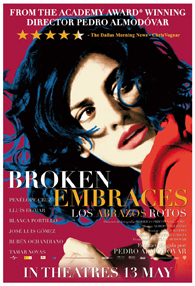
Pedro Almodovar goes back to the basics of storytelling with his rather complex Broken Embraces. On the face of things, it’s a noir mystery that sets up questions from the beginning like: Why would a successful director (Lluis Homar), land up as a blind writer working and living under an assumed name (“Harry Caine”)? What happened to the bombshell actress (Penelope Cruz) from his last and greatest film, whose photo is kept in a dossier in his desk drawer? Who is the mysterious stranger who commissions him to write a screenplay that he rejects, and what does that screenplay and that mysterious stranger have to do with the first two mysteries? And from these initial questions, Almodovar weaves a tale full of power, passion, obsession, and vengeance.
As a straightforward noir film, Broken Embraces doesn’t need an Almodovar to be great. But this is Almodovar we’re talking about, and what he brings to the film is a rarefied form of storytelling.
Consider the amount of flashbacks that this noir mystery needs in its telling. Now double it because Almodovar does something very complicated: there’s the story that takes place in the present, the extended flashback that we watch, the silent “making of” footage that the bombshell actress’s stepson films, which his father (the bombshell’s tycoon husband and producer of the set) jealously watches on the sly, and the film that Harry Caine was shooting, that we the audience recognise as a alternate version of Almodovar’s Women on the verge of a nervous breakdown.
Every character in this mystery sustains their pleasures and passions by enacting, watching, making (and secretly watching and making) remembering, and mis-remembering films. The very human displays of obsession, voyeurism and passion is refracted through the obsession and passion for the act of consuming film – making Broken Embraces Almodovar’s subtle tribute to cinema and film watching, and one of his most intellectual as well as emotional features yet.












 列印版本
列印版本










讀者回應
搶先發表第一個回應吧!
請先登入再使用此功能。